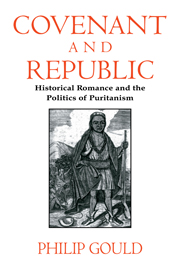Book contents
- Frontmatter
- Contents
- Acknowledgments
- Introduction: The Historicity of Historical Fiction
- 1 The New Ebenezer: Republican Virtue, the Puritan Fathers, and Early National History-Writing
- 2 Catharine Sedgwick's “Recital” of the Pequot War
- 3 Refashioning the Republic: Gender, Ideology, and the Politics of Virtue in Hobomok and Hope Leslie
- 4 The “Hive of America”: James Fenimore Cooper's The Wept of Wish-ton-Wish and the History of King Philip's War
- 5 Witch-Hunting and the Politics of Reason
- Afterword: American Origins of Puritan Selves
- Notes
- Index
- Titles in the series
3 - Refashioning the Republic: Gender, Ideology, and the Politics of Virtue in Hobomok and Hope Leslie
Published online by Cambridge University Press: 23 November 2009
- Frontmatter
- Contents
- Acknowledgments
- Introduction: The Historicity of Historical Fiction
- 1 The New Ebenezer: Republican Virtue, the Puritan Fathers, and Early National History-Writing
- 2 Catharine Sedgwick's “Recital” of the Pequot War
- 3 Refashioning the Republic: Gender, Ideology, and the Politics of Virtue in Hobomok and Hope Leslie
- 4 The “Hive of America”: James Fenimore Cooper's The Wept of Wish-ton-Wish and the History of King Philip's War
- 5 Witch-Hunting and the Politics of Reason
- Afterword: American Origins of Puritan Selves
- Notes
- Index
- Titles in the series
Summary
The great object of history is to teach us how we may become good citizens, not only as the ancients understood the word, but as its present broad and comprehensive meaning denotes – considering every individual as a member of the great human family, and as such bound to acts of kindness and charity to every other … in a word, it inculcates a liberal philosophy … a wide philanthropy … whether of a political nature or belonging to the gentler connections of social life.
– “The Philosophy of History,” North American Review (1834)In general, it may be said, that the proper end of all reading is to make “good men and good citizens.” But by what particular steps is History to subserve this end?
– Charles Goodrich, History of the United States (1829)Hope Leslie's story of the Pequot War begins to reveal both the problems and the possibilities for those women writers of the early republic who wrote (and rewrote) Puritan history. Yet Sedgwick's novel raises a prickly issue concerning its own reception in the 1820s. How could a historical work, which discredited those masculine ideologies of “republicanism” rooted in the American Revolution, still be a popular and critical success? This chapter takes up this issue with regard to the whole of Hope Leslie and its counterpart, Lydia Maria Child's first novel, Hobomok, published a few years before, in 1824. The key to their revisions of gender-ideology and their simultaneous popularity lies in the transitional nature of the early republic itself.
- Type
- Chapter
- Information
- Covenant and RepublicHistorical Romance and the Politics of Puritanism, pp. 91 - 132Publisher: Cambridge University PressPrint publication year: 1996



